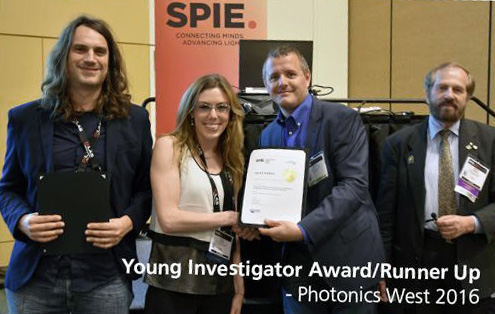 Haley Marks, graduate student in the Department of Biomedical Engineering at Texas A&M University, has been recognized for her work developing a handheld device that tests for trace levels of toxins in blood at this year’s 2016 Photonics West symposium in San Francisco.
Haley Marks, graduate student in the Department of Biomedical Engineering at Texas A&M University, has been recognized for her work developing a handheld device that tests for trace levels of toxins in blood at this year’s 2016 Photonics West symposium in San Francisco.
Marks was awarded first runner-up in the Ocean Optics Young Investigator competition at this year’s symposium for her research paper detailing the development of the technology. As an award recipient, Marks, who is advised by Professor Gerard Coté, Charles H. & Bettye Barclay Professor in Biomedical Engineering and director of the Center for Remote Health Technologies and Systems, received a $500 cash prize, and the laboratory where her research is performed received a $1,000 equipment credit from Ocean Optics.
The Young Investigator Award is presented to a researcher who is a graduate student or who has completed their graduate work in the last five years and is the primary author of the best juried paper submitted as part of the “Colloidal Nanocrystals for Biomedical Applications XI” conference at the 2016 Photonics West symposium. Ocean Optics, an industry leader in modular spectroscopy applications and products, has sponsored the Young Investigator Award since 2005.
Authorities on biophotonics, nanophotonics and biomedical optics from throughout the world convene annually at the high-tech symposium to discuss their cutting-edge work. Each year, the symposium attracts more than 20,000 people who want to see, learn about and purchase the latest devices, components and systems that are driving trends such as state-of-the art medical technologies, smart manufacturing and autonomous vehicles.
As part of a collaboration involving Texas A&M, Strathclyde University in Scotland and BasePair Biotechnologies of Houston, Marks is developing a “lab-on-a-chip” device that will ultimately have the ability to deliver blood results in minutes, eliminating much of the need for a skilled technician and laboratory.
Marks, who is working on the sensing chemistry for the chip, is using magnetic nanoparticles to detect bisphenol A (BPA) in blood. BPA is an industrial chemical found in certain plastics and resins, such as those used to make water bottles. Some research has linked exposure to BPA to negative health effects on the brain, behavior and prostate gland of fetuses, infants and children and even increased blood pressure. The chemical has been traditionally hard to detect because it doesn’t trigger an immune response from the body, underscoring the need for enhanced detection technology, Marks says. As the technology continues to be refined, Marks and her team intend to expand its capabilities so that it can be used to identify other difficult-to-detect chemicals in blood.
About the Center for Remote Health Technologies and Systems
To enable healthy living through design and development of advanced technology and information systems is at the core of the center’s vision. To accomplish this vision, the mission of the center is to identify and overcome the unmet patient and health care provider needs through development of breakthrough health care devices, technologies and information systems toward health monitoring and disease diagnosis, management and prevention in the home or in the field.
About the Department of Biomedical Engineering
Committed to solving the world’s greatest health problems through the exploration of new ideas, integrated research and innovation, the Department of Biomedical Engineering at Texas A&M is producing the next generation of biomedical engineers, developing new technologies and new jobs, and achieving revolutionary advancements for the future of health care. The department has unique strengths in regenerative engineering, medical augmentation, molecular diagnostics/theranostics, tele-health, and precision medicine, and its faculty members are internationally recognized with collaborative relationships that span engineering, physical and natural sciences, medicine and veterinary sciences.